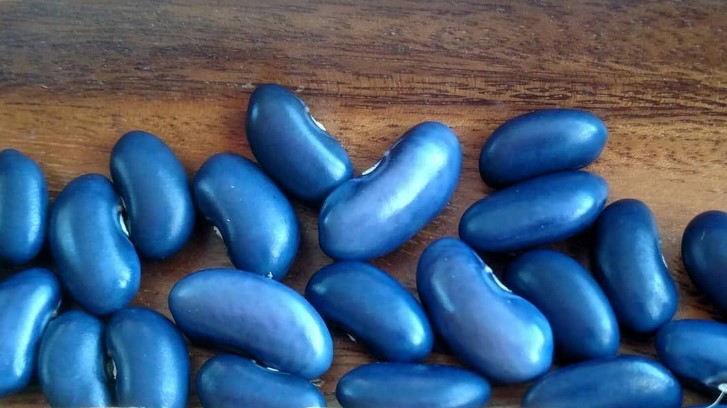Origin: The blue bean is a shrub indigenous to western China, renowned for its striking metallic-blue pods resembling broad beans, and is often grown for ornamental purposes. Despite being an edible crop and an abundant source of rubber, it is relatively obscure beyond its native region. This plant is indigenous to eastern Asia and can be found from China’s western region to Nepal, and southward to Myanmar.
Description: This upright shrub can reach heights of 3-6m (10-20ft) with a width of 3m (10ft), featuring sparsely branched thick, shiny, pithy branches and notably large winter buds. Its large pinnate leaves, which are 60-100cm (24-39ins) long, consist of 13-25 deep green leaflets (with a blue tinge when young) and blue-green undersides, resembling oversized potato leaves.
The shrub produces yellowish-green flowers on long stalks in racemes up to 50cm (20ins) long from May to June. The fruit consists of pods, which are 7-15cm (3-6ins) long by 1.5-2.5cm (0.6-1ins) wide, typically borne in groups of three, with a rough and warty outer surface. Initially green, the pods transform into a vivid metallic blue color and become soft as they ripen, typically in October, splitting open to reveal transparent-whitish jelly-like contents containing numerous small black disc-shaped seeds, roughly 4mm (0.2ins) across.

Uses: The sweet, raw pulp within the pods possesses a delicate melon flavor and can be consumed by peeling off the skin in a similar fashion to broad beans. The pulp contains two lines of seeds that are safe to swallow. In Chinese medicine, (Decaisnea fargesii) is frequently utilized as an antirheumatic and antitussive agent, with a particular emphasis on the stems.
It is essential to note that while the contents of the pod are indeed edible, the shell itself is not. The pod shell contains white latex, consisting of various terpene hydrocarbons and rubber (C5H8), found within a series of canals. Upon splitting the pod open, the latex can be observed oozing from the edges, presenting an opportunity for rubber extraction.
Cultivation: Blue bean is a resilient shrub that can thrive in both sun and semi-shade, with a preference for moist, well-drained soil that is rich in nutrients. It is not drought-tolerant and will require some shelter to prevent damage to its somewhat brittle branches during strong winds. Late spring frosts can occasionally damage new growth.
The plant grows at a rapid pace, approximately 40cm (16ins) per year, and will typically produce flowers and fruits annually in the UK. It takes around five years for the shrub to start bearing fruits, which will ripen during late September and October. Pruning is typically unnecessary, and propagation occurs through seeds. The best results are achieved by utilizing fresh seeds, sowing them in the autumn, or stratifying them over the winter, as they have a slow germination rate in the spring.
Family: The genus of a flowering plant called Decaisnea Hook, belongs to the family Lardizabalaceae.
Other Names: It is also known by its common names such as dead man’s fingers, blue bean plant, or blue sausage fruit.
Pests and diseases: As off, there are no pests or diseases of note.
Related species: D. insignis, a closely related shrub originating from the eastern Himalayas, bears a striking resemblance to the Blue bean, with the exception of its thicker, curved, and yellow fruits. This species is less hardy, only tolerating conditions up to zone 8/H4. Similar to Blue bean, the pulp of D. insignis is also safe for consumption.
Varieties/Cultivars: So far, there is none. Read More – Why Soybeans are Beneficial?
